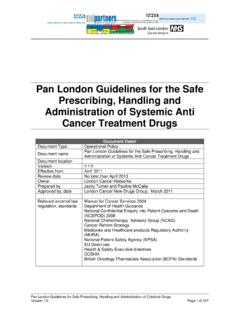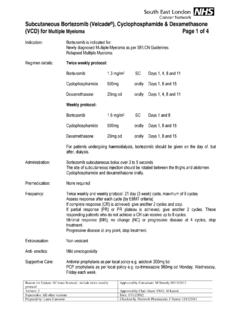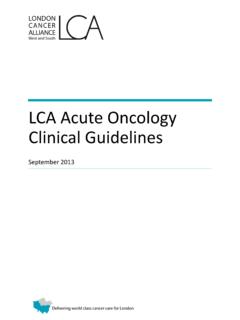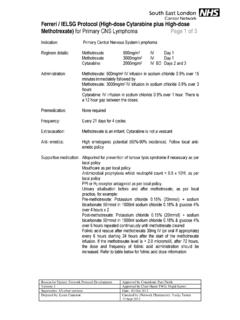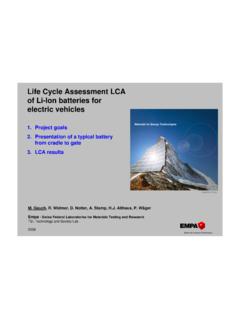Transcription of LCA Haemato-Oncology Clinical Guidelines
1 LCA Haemato-Oncology Clinical Guidelines Acute Leukaemias and Myeloid Neoplasms Part 4: Myeloproliferative Neoplasms April 2015. LCA Haemato-Oncology Clinical Guidelines . Contents 1. Introduction .. 4. 2. Clinical Features .. 6. Essential thrombocythaemia (ET) .. 6. Polycythaemia vera (PV) .. 6. Primary myelofibrosis (PMF) .. 6. 3. Referral Pathways .. 7. Children, teenagers and young adults .. 8. Teenagers and young adults .. 9. 4. Investigation and Diagnosis .. 10. Essential thrombocythaemia (ET) .. 10. Polycythaemia vera (PV) .. 12. Primary myelofibrosis (PMF) .. 15. Pathology .. 16. Imaging .. 16. 5. Risk Stratification .. 17. Essential thrombocythaemia (ET) .. 17. Polycythaemia vera (PV) .. 17. Primary myelofibrosis (PMF) .. 18. 6. Patient Information/Support .. 20. 7. Treatment .. 21. Essential thrombocythaemia (ET).
2 21. Polycythaemia vera (PV) .. 25. Primary (or secondary) myelofibrosis (PMF, PPV-MF, PET-MF) .. 29. Fertility .. 32. 8. Supportive 33. Anaemia .. 33. Haemostasis and thrombosis .. 33. Hyperviscosity syndrome .. 33. Infection .. 33. Pain management .. 33. 2. CONTENTS. Other symptom control .. 33. 34. Weight loss .. 34. Complex symptom management .. 34. 9. Treatment Summary and Care Plan .. 35. Treatment summary and care 35. 10. Follow-up Arrangements .. 36. 11. Rehabilitation and Survivorship .. 36. 12. Research/ Clinical Trials .. 36. 13. End-of-life Care .. 37. 14. Data Requirements .. 37. References .. 38. Annex 1: LCA Acute Leukaemias and Myeloid Neoplasms BMAT Diagnostics Summary 41. Annex 2: Multidisciplinary Teams (MDTs) and Constituent Hospital Trusts .. 42. Annex 3: LCA Oral Chemotherapy Patient Education Checklist.
3 43. Annex 4: Nurse-led MPN Clinic SOP and Referral Guideline .. 45. Annex 5: SIHMDS or Current Diagnostic Services and Contacts .. 50. Annex 6: JACIE-accredited Transplant Centres in the LCA .. 51. Annex 7: Data Requirements .. 52. Appendices .. 54. 3. LCA Haemato-Oncology Clinical Guidelines . 1. Introduction Myeloproliferative neoplasms (MPN) conditions include essential thrombocythaemia (ET), polycythaemia vera (PV) and primary myelofibrosis (PMF). They are all closely related and have an intrinsic tendency to evolve into acute myeloid leukaemia (AML), confirming their classification as haemato -oncological disorders. MPNs are perhaps the orphan diseases of Haemato-Oncology , but these patients, if managed judiciously, have prolonged survival, with a median survival greater than 10 15 years for ET and PV. However, available treatments have significant side-effect profiles and need to be chosen with care, particularly in young patients.
4 The last decade has seen the publication of a considerable body of Clinical data informing Clinical decisions. Many therapeutic options, however, remain unlicensed and there have been few good quality Clinical trials. The recent publication of the high frequency of mutations in calreticulin (CALR) merits their inclusion in diagnostic criteria. The following sections contain current management protocols for ET, PV and primary MF (including MF in patients with an antecedent history of ET and PV). Management protocols for women in pregnancy and in the three months before conception are more complex and individualised; these cases should be discussed with a consultant haematologist with expertise in this area. Other entities within the MPN group MPNU, chronic eosinophilia, chronic neutrophilic leukaemia and mast cell disorders are not covered in these Guidelines .
5 These conditions listed in the World Health Organization (WHO) criteria for MPN 2008 (WHO Classification of Tumours of Haematopoietic and Lymphoid Tissues. IARC, Lyon 2008) are: Myeloproliferative neoplasms: Chronic myelogenous leukaemia, BCR-ABL+ (CML) see LCA Haemato-Oncology Clinical Guidelines Part 3: Chronic Myeloid Leukaemia Chronic neutrophilic leukaemia (CNL). Polycythaemia vera (PV). Primary myelofibrosis (PMF). Essential thrombocythaemia (ET). Chronic eosinophilic leukaemia, NOS (CEL, NOS). Mastocytosis Myeloproliferative neoplasm, unclassifiable (MPN, U). Myeloid and lymphoid neoplasms with eosinophilia and abnormalities of PDGFRA, PDGFRB, FGFR1: Myeloid and lymphoid neoplasms with PDGFRA rearrangement Myeloid and lymphoid neoplasms with PDGFRB rearrangement Myeloid and lymphoid neoplasms with FGFR1 abnormalities 4.
6 INTRODUCTION. Myelodysplastic/myeloproliferative neoplasms (MDS/MPN): Chronic myelomonocytic leukaemia (CMML). Atypical chronic myeloid leukaemia, BCR-ABLneg (aCML). Juvenile myelomonocytic leukaemia (JMML). Myelodysplastic/myeloproliferative neoplasm, unclassifiable (MDS/MPN, U). Provisional entity: refractory anaemia with ring sideroblasts and thrombocytosis (RARS-T). 5. LCA Haemato-Oncology Clinical Guidelines . 2. Clinical Features Essential thrombocythaemia (ET). ET is characterised by a persistent thrombocytosis. The previously accepted platelet count threshold >600 x 109/L has been revised to >450 x 109/L. Short-term complications of ET include thrombosis and, less frequently, haemorrhage. In common with PV, long-term problems include MF and acute leukaemia, although these are less frequent in ET. Thrombotic events affect the arterial and venous macro and microvasculature, as well as the placental circulation.
7 Microvascular events predominate in ET typically causing erythromelalgia (asymmetric erythema, congestion and burning pain in the hands and feet), which may progress to ischaemia and gangrene, migraine-like headaches and transient ischaemic attacks (TIAs). Approximately 30 50% of patients are symptomatic at presentation. Polycythaemia vera (PV). PV is characterised by an erythrocytosis (packed cell volume (PCV) > in men and > in women) and sometimes thrombocytosis and neutrophilia. The median age at presentation is 55 60 years. Vascular thromboses, especially arterial events and more rarely bleeding, are major short-term events. In the longer term (10 15 years), MF or spent phase' occurs and AML (partially treatment related) in 5 10%. of patients. Aquagenic pruritus, gout and splenomegaly are also classical Clinical features, but only occur in a few patients.
8 Primary myelofibrosis (PMF). Chronic idiopathic myelofibrosis, also known as agnogenic myeloid metaplasia, PMF may arise de novo or as a late phase of ET, and particularly PV known as post-PV (PPV)-MF and post-ET (PET)-MF. Fibrosis is thought to arise from an interaction between diseased megakaryocytes, releasing mitogens such as platelet-derived growth factor (PDGF) and transforming growth factor that directly increase fibroblast proliferation. PMF has a median age of presentation of 50 60 years. Symptoms relate to bone marrow failure (anaemia, infection, bleeding) or progressive splenomegaly (pain, weight loss, sweating). Progression to acute leukaemia occurs in up to 25% of patients (more than PV or ET) and may be associated with extramedullary collections of myeloid progenitors (chloromas). 6. REFERRAL PATHWAYS. 3. Referral Pathways Patients with a high WBC, haemoglobin/PCV or platelet count and/or suspected MPN by other means ( splenomegaly, unprovoked and unusual site for a thrombotic episode) should be referred to a haematologist for assessment, via a 2 week wait pathway (see Appendix 1: 2 Week Wait Referral Forms).
9 All new patients should be referred to the MDT for confirmation of diagnosis, prognosis and management plan, taking into account their performance status, needs and co-morbidities (Annex 2). A joint approach with elderly care physicians and palliative care teams may be appropriate, depending on the performance status of the patient and the phase of disease. The following patients should be referred to the MDT: All new patients with MPN in order to confirm the diagnosis and treatment plan All patients where a new line of therapy needs to be considered All patients with a restaging assessment All patients in whom an allogeneic stem cell transplant is a consideration. Information to be captured and documented prior to, or during, the MDT includes: Demographic information Referring physician and/or GP. Performance status An indicator of co-morbidities ( co-morbidity score).
10 Any relevant history Pertinent positive and negative findings on physical examination (splenomegaly, rashes, etc.). Spleen size (by ultrasound). FBC, haematinics, LFTs, U&E, LDH, urate, reticulocyte count, DAT, AIS, SPEP, serum erythropoietin, transfusion dependency Bone marrow aspirate and trephine histology (where available). Bone marrow aspirate immunophenotyping, if relevant Cytogenetic status (if relevant). Mutational status Specific diagnosis/category of MPN. Other relevant imaging Risk score Availability of a Clinical trial/research study and whether the patient is eligible Management and treatment plan Key worker/ Clinical nurse specialist Named consultant or team (as per local work patterns). 7. LCA Haemato-Oncology Clinical Guidelines . The MDT outcome form should be sent to the GP (by email, or preferably by fax) within 24 working hours of the MDT discussion.



